Human Resource Management Report: HRM Strategies and Practices
VerifiedAdded on 2020/02/03
|14
|4173
|292
Report
AI Summary
This report provides a comprehensive overview of Human Resource Management (HRM), covering key functions, planning, recruitment, employee relations, motivation, and reward systems. It begins by differentiating between personnel and human resource management, outlining HRM functions such as recruitment, employee relations, and training and development, and detailing the roles and responsibilities of line managers. The report then examines the impact of the legal framework on HRM, including employment legislation. Task 2 delves into human resource planning, exploring reasons for its importance, stages of planning, and the recruitment and selection processes of Mark and Spencer and Posh Nosh Limited, along with an assessment of the effectiveness of these techniques. Task 3 focuses on motivational theory and reward systems, and the process of job evaluation. Finally, Task 4 addresses the reasons for employment cessation, termination procedures, and the impact of the legal framework on employment cessation. The report concludes with a synthesis of the key findings and recommendations for effective HRM practices.
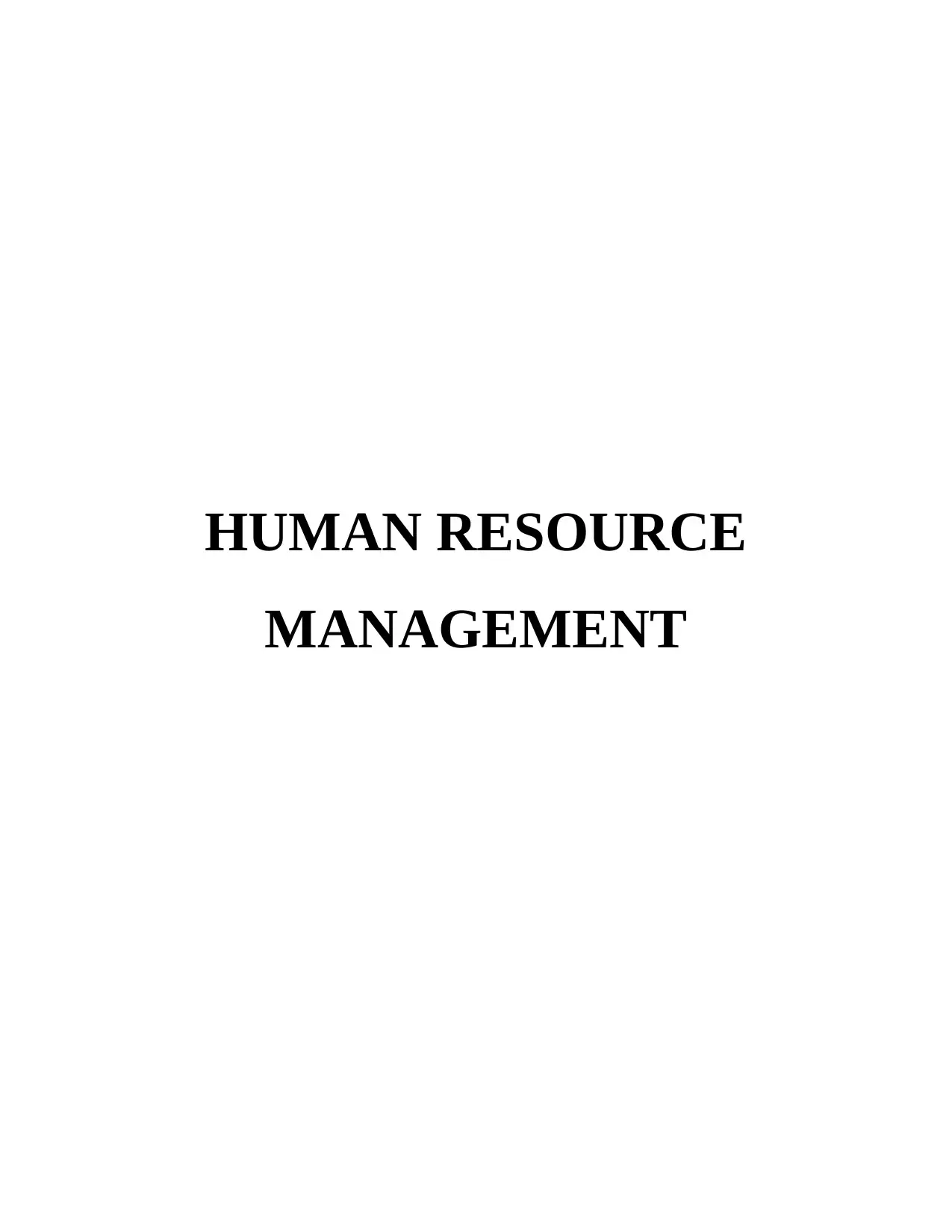
HUMAN RESOURCE
MANAGEMENT
MANAGEMENT
Paraphrase This Document
Need a fresh take? Get an instant paraphrase of this document with our AI Paraphraser
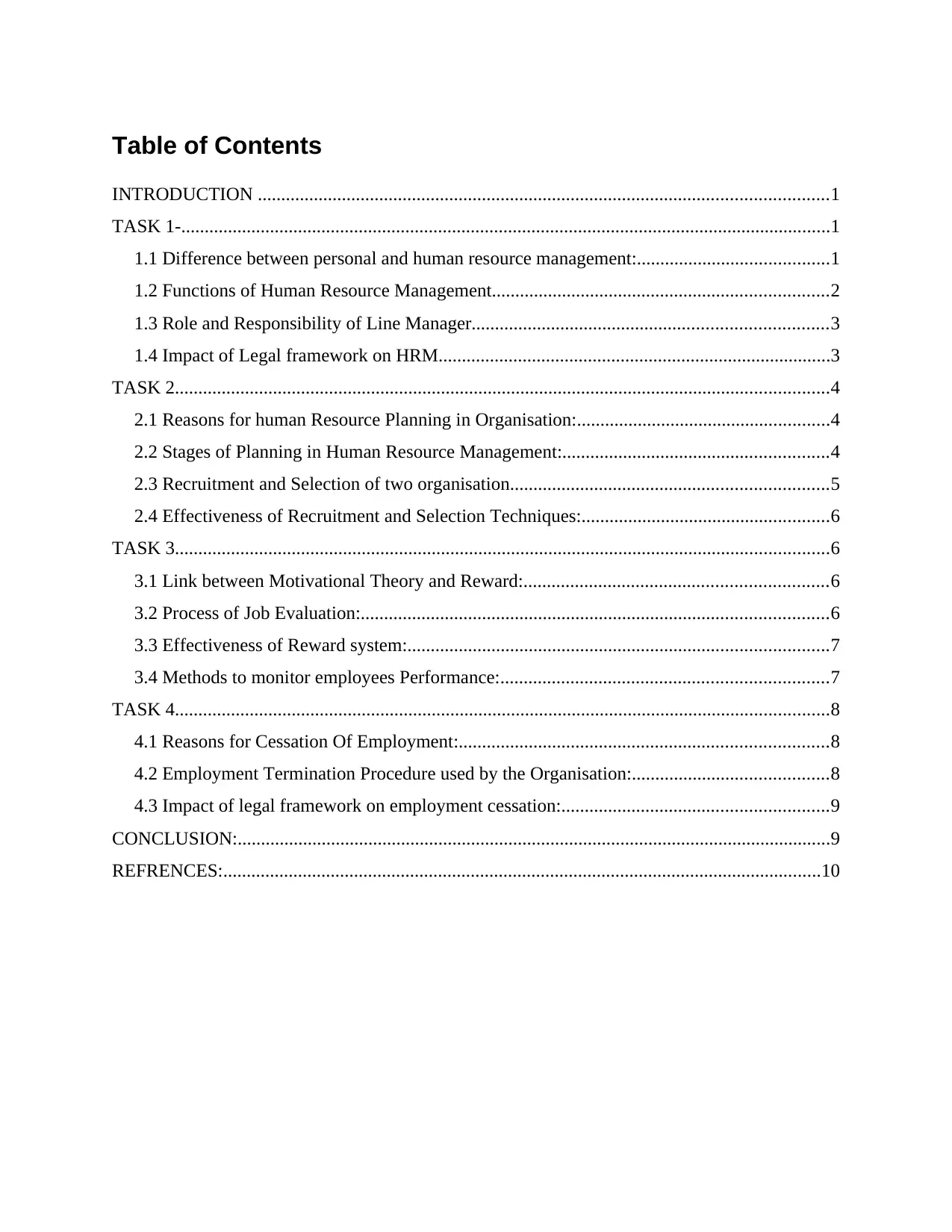
Table of Contents
INTRODUCTION ..........................................................................................................................1
TASK 1-...........................................................................................................................................1
1.1 Difference between personal and human resource management:.........................................1
1.2 Functions of Human Resource Management........................................................................2
1.3 Role and Responsibility of Line Manager............................................................................3
1.4 Impact of Legal framework on HRM....................................................................................3
TASK 2............................................................................................................................................4
2.1 Reasons for human Resource Planning in Organisation:......................................................4
2.2 Stages of Planning in Human Resource Management:.........................................................4
2.3 Recruitment and Selection of two organisation....................................................................5
2.4 Effectiveness of Recruitment and Selection Techniques:.....................................................6
TASK 3............................................................................................................................................6
3.1 Link between Motivational Theory and Reward:.................................................................6
3.2 Process of Job Evaluation:....................................................................................................6
3.3 Effectiveness of Reward system:..........................................................................................7
3.4 Methods to monitor employees Performance:......................................................................7
TASK 4............................................................................................................................................8
4.1 Reasons for Cessation Of Employment:...............................................................................8
4.2 Employment Termination Procedure used by the Organisation:..........................................8
4.3 Impact of legal framework on employment cessation:.........................................................9
CONCLUSION:...............................................................................................................................9
REFRENCES:................................................................................................................................10
INTRODUCTION ..........................................................................................................................1
TASK 1-...........................................................................................................................................1
1.1 Difference between personal and human resource management:.........................................1
1.2 Functions of Human Resource Management........................................................................2
1.3 Role and Responsibility of Line Manager............................................................................3
1.4 Impact of Legal framework on HRM....................................................................................3
TASK 2............................................................................................................................................4
2.1 Reasons for human Resource Planning in Organisation:......................................................4
2.2 Stages of Planning in Human Resource Management:.........................................................4
2.3 Recruitment and Selection of two organisation....................................................................5
2.4 Effectiveness of Recruitment and Selection Techniques:.....................................................6
TASK 3............................................................................................................................................6
3.1 Link between Motivational Theory and Reward:.................................................................6
3.2 Process of Job Evaluation:....................................................................................................6
3.3 Effectiveness of Reward system:..........................................................................................7
3.4 Methods to monitor employees Performance:......................................................................7
TASK 4............................................................................................................................................8
4.1 Reasons for Cessation Of Employment:...............................................................................8
4.2 Employment Termination Procedure used by the Organisation:..........................................8
4.3 Impact of legal framework on employment cessation:.........................................................9
CONCLUSION:...............................................................................................................................9
REFRENCES:................................................................................................................................10
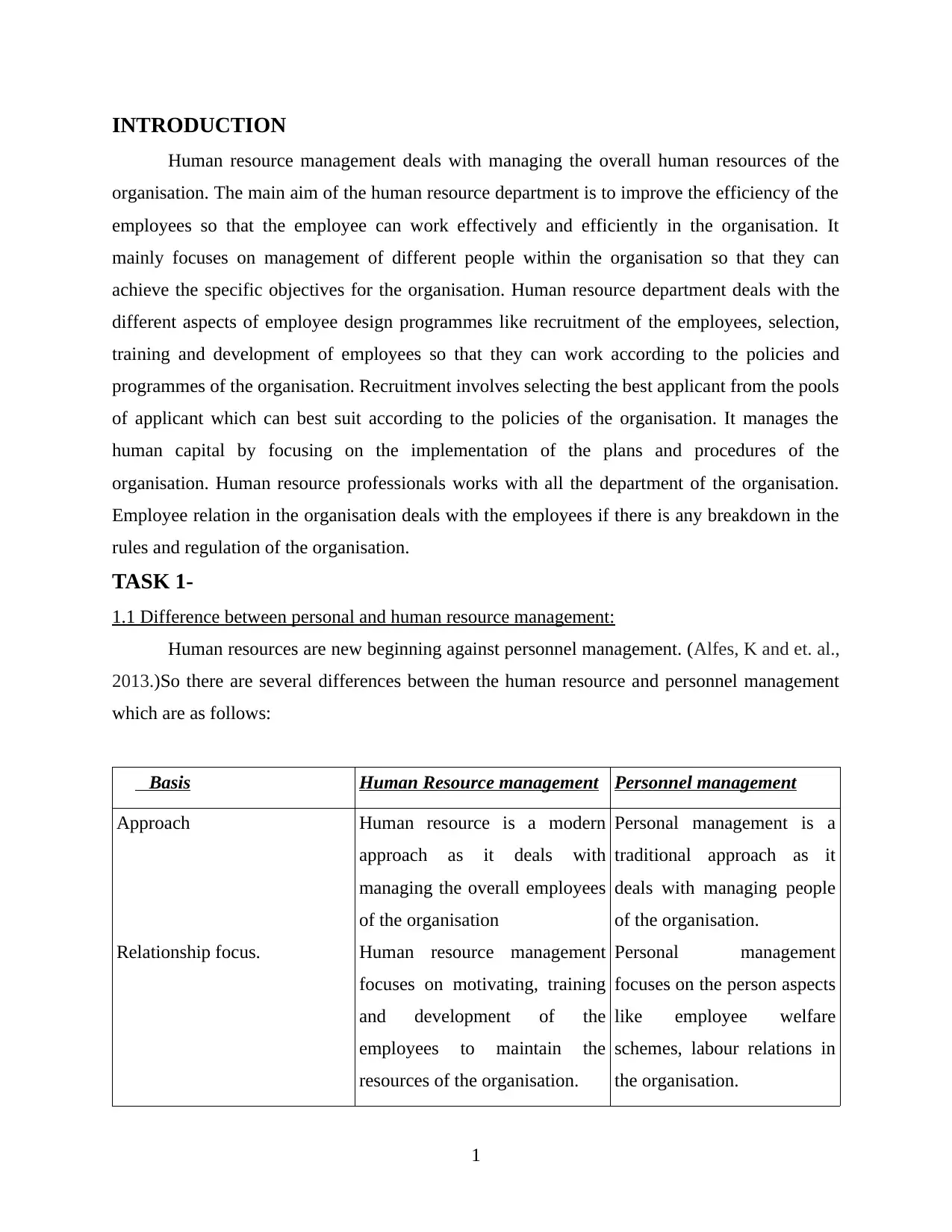
INTRODUCTION
Human resource management deals with managing the overall human resources of the
organisation. The main aim of the human resource department is to improve the efficiency of the
employees so that the employee can work effectively and efficiently in the organisation. It
mainly focuses on management of different people within the organisation so that they can
achieve the specific objectives for the organisation. Human resource department deals with the
different aspects of employee design programmes like recruitment of the employees, selection,
training and development of employees so that they can work according to the policies and
programmes of the organisation. Recruitment involves selecting the best applicant from the pools
of applicant which can best suit according to the policies of the organisation. It manages the
human capital by focusing on the implementation of the plans and procedures of the
organisation. Human resource professionals works with all the department of the organisation.
Employee relation in the organisation deals with the employees if there is any breakdown in the
rules and regulation of the organisation.
TASK 1-
1.1 Difference between personal and human resource management:
Human resources are new beginning against personnel management. (Alfes, K and et. al.,
2013.)So there are several differences between the human resource and personnel management
which are as follows:
Basis Human Resource management Personnel management
Approach
Relationship focus.
Human resource is a modern
approach as it deals with
managing the overall employees
of the organisation
Human resource management
focuses on motivating, training
and development of the
employees to maintain the
resources of the organisation.
Personal management is a
traditional approach as it
deals with managing people
of the organisation.
Personal management
focuses on the person aspects
like employee welfare
schemes, labour relations in
the organisation.
1
Human resource management deals with managing the overall human resources of the
organisation. The main aim of the human resource department is to improve the efficiency of the
employees so that the employee can work effectively and efficiently in the organisation. It
mainly focuses on management of different people within the organisation so that they can
achieve the specific objectives for the organisation. Human resource department deals with the
different aspects of employee design programmes like recruitment of the employees, selection,
training and development of employees so that they can work according to the policies and
programmes of the organisation. Recruitment involves selecting the best applicant from the pools
of applicant which can best suit according to the policies of the organisation. It manages the
human capital by focusing on the implementation of the plans and procedures of the
organisation. Human resource professionals works with all the department of the organisation.
Employee relation in the organisation deals with the employees if there is any breakdown in the
rules and regulation of the organisation.
TASK 1-
1.1 Difference between personal and human resource management:
Human resources are new beginning against personnel management. (Alfes, K and et. al.,
2013.)So there are several differences between the human resource and personnel management
which are as follows:
Basis Human Resource management Personnel management
Approach
Relationship focus.
Human resource is a modern
approach as it deals with
managing the overall employees
of the organisation
Human resource management
focuses on motivating, training
and development of the
employees to maintain the
resources of the organisation.
Personal management is a
traditional approach as it
deals with managing people
of the organisation.
Personal management
focuses on the person aspects
like employee welfare
schemes, labour relations in
the organisation.
1
⊘ This is a preview!⊘
Do you want full access?
Subscribe today to unlock all pages.

Trusted by 1+ million students worldwide

Assumption
Decisions
Human resources is based on the
assumption that people of the
organisation are important
resources for achieving the
inputs of the organisation.
The decisions in human resource
departments are made by
collectively after the decisions
are discussed with the
employees of the organisation so
that there is no decentralization
of power and authority.
Personnel management is
based on the assumption that
people are inputs for
achieving the outputs of the
organisation.
The decisions in personnel
management is taken by the
higher authority that is the
top level management.
1.2 Functions of Human Resource Management.
There are many functions related with the human resource department but the main
functions are as follows:
Recruitment: Recruitment is the process of searching for the prospecting
employees and stimulating them to apply for the vacant post in the company.
Recruitment process begins when a candidate is in need of a job and company has
a vacant post but the candidate should fulfil the criteria as desired by the
company.(, E and Wu, L., 2012.)
Employee Relations: Employee relations within the organisation is the main
function of human resource management. The relation between the employer and
the employee should be such that if the employee is facing any problem he can
share his problem with the employer so that the problem can be resolved.
Employees should be strengthened on the work performance, job satisfaction and
employee engagement programmes within the organisation.
Training and Development: Training and development of the employees is an
important tools to success for the organisation .Training enhances the efficiency
of the employees and thus it helps in the overall development of the organisation.
2
Decisions
Human resources is based on the
assumption that people of the
organisation are important
resources for achieving the
inputs of the organisation.
The decisions in human resource
departments are made by
collectively after the decisions
are discussed with the
employees of the organisation so
that there is no decentralization
of power and authority.
Personnel management is
based on the assumption that
people are inputs for
achieving the outputs of the
organisation.
The decisions in personnel
management is taken by the
higher authority that is the
top level management.
1.2 Functions of Human Resource Management.
There are many functions related with the human resource department but the main
functions are as follows:
Recruitment: Recruitment is the process of searching for the prospecting
employees and stimulating them to apply for the vacant post in the company.
Recruitment process begins when a candidate is in need of a job and company has
a vacant post but the candidate should fulfil the criteria as desired by the
company.(, E and Wu, L., 2012.)
Employee Relations: Employee relations within the organisation is the main
function of human resource management. The relation between the employer and
the employee should be such that if the employee is facing any problem he can
share his problem with the employer so that the problem can be resolved.
Employees should be strengthened on the work performance, job satisfaction and
employee engagement programmes within the organisation.
Training and Development: Training and development of the employees is an
important tools to success for the organisation .Training enhances the efficiency
of the employees and thus it helps in the overall development of the organisation.
2
Paraphrase This Document
Need a fresh take? Get an instant paraphrase of this document with our AI Paraphraser

1.3 Role and Responsibility of Line Manager.
Line managers are the persons who are involved in running the main business activities
of the organisation and their main aim is to earn profit.
Role of line managers:
Line managers plays important role in leading the staffing activities of the
organisation. It therefore manages all the issues of the organisation.
They consider all the risk factors prevailing in the organisation and take actions to
solve the risk in a safely manner which could not hamper the organisation.
The line mangers seek advice and takes guides from the HR manger if they are
not able to handle the situation.(Armstrong, M and Taylor, S., 2014)
Responsibility of line manager:
Employee Engagement: Line mangers are involved in employee engagement
programmes because this helps to strengthen open communication between the
employees. They motivate the employee to use their skill and abilities in
performing the activities of the organisation.
Performance Appraisal: Line mangers implement the performance appraisal of the
employees. Performance appraisal helps in evaluating the overall performance of
the employees and are rated according and feedback is provided to the employees
by the line manager.
1.4 Impact of Legal framework on HRM
Employment legislation is concern with the body of laws that helps in smooth running of
the activities between the employer and the employee within the organisation.( R and Colvin,
A.J., 2011)The issues related with discrimination at the work place, conditions of work
environment and safety at the work place these issues are involved by the legislations which are
stated as:
Equal Pay Act (1970): Equal pay act implies that there should be no
discrimination on the basis of gender, cast, creed or colour. Every person who is
employed in organisation has right to equal pay.
National Minimum wage act(1998): The national minimum wage implies that a
person employed in the organisation should get minimum wages according to
daily or monthly basis as decided by the company. The wage rate is fixed by the
3
Line managers are the persons who are involved in running the main business activities
of the organisation and their main aim is to earn profit.
Role of line managers:
Line managers plays important role in leading the staffing activities of the
organisation. It therefore manages all the issues of the organisation.
They consider all the risk factors prevailing in the organisation and take actions to
solve the risk in a safely manner which could not hamper the organisation.
The line mangers seek advice and takes guides from the HR manger if they are
not able to handle the situation.(Armstrong, M and Taylor, S., 2014)
Responsibility of line manager:
Employee Engagement: Line mangers are involved in employee engagement
programmes because this helps to strengthen open communication between the
employees. They motivate the employee to use their skill and abilities in
performing the activities of the organisation.
Performance Appraisal: Line mangers implement the performance appraisal of the
employees. Performance appraisal helps in evaluating the overall performance of
the employees and are rated according and feedback is provided to the employees
by the line manager.
1.4 Impact of Legal framework on HRM
Employment legislation is concern with the body of laws that helps in smooth running of
the activities between the employer and the employee within the organisation.( R and Colvin,
A.J., 2011)The issues related with discrimination at the work place, conditions of work
environment and safety at the work place these issues are involved by the legislations which are
stated as:
Equal Pay Act (1970): Equal pay act implies that there should be no
discrimination on the basis of gender, cast, creed or colour. Every person who is
employed in organisation has right to equal pay.
National Minimum wage act(1998): The national minimum wage implies that a
person employed in the organisation should get minimum wages according to
daily or monthly basis as decided by the company. The wage rate is fixed by the
3
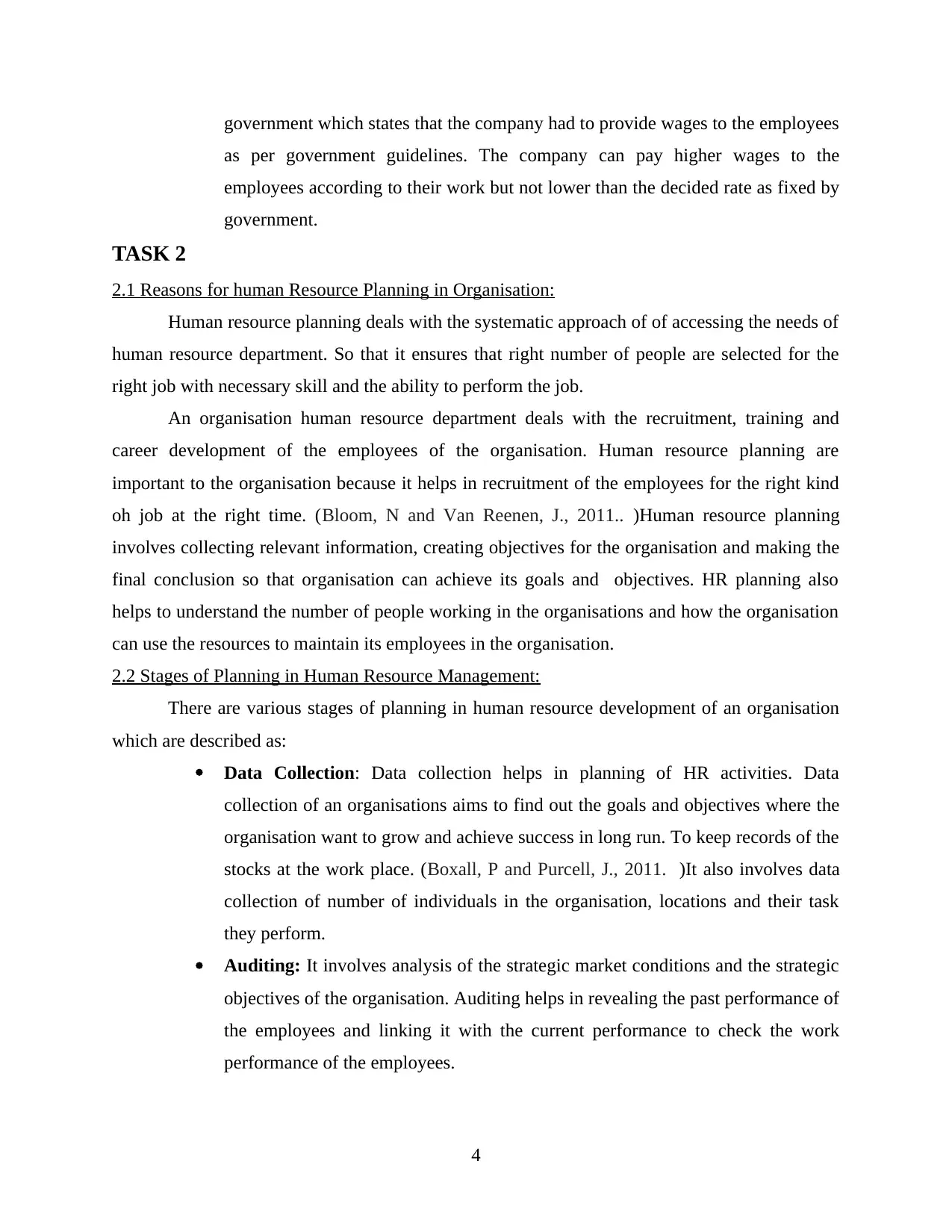
government which states that the company had to provide wages to the employees
as per government guidelines. The company can pay higher wages to the
employees according to their work but not lower than the decided rate as fixed by
government.
TASK 2
2.1 Reasons for human Resource Planning in Organisation:
Human resource planning deals with the systematic approach of of accessing the needs of
human resource department. So that it ensures that right number of people are selected for the
right job with necessary skill and the ability to perform the job.
An organisation human resource department deals with the recruitment, training and
career development of the employees of the organisation. Human resource planning are
important to the organisation because it helps in recruitment of the employees for the right kind
oh job at the right time. (Bloom, N and Van Reenen, J., 2011.. )Human resource planning
involves collecting relevant information, creating objectives for the organisation and making the
final conclusion so that organisation can achieve its goals and objectives. HR planning also
helps to understand the number of people working in the organisations and how the organisation
can use the resources to maintain its employees in the organisation.
2.2 Stages of Planning in Human Resource Management:
There are various stages of planning in human resource development of an organisation
which are described as:
Data Collection: Data collection helps in planning of HR activities. Data
collection of an organisations aims to find out the goals and objectives where the
organisation want to grow and achieve success in long run. To keep records of the
stocks at the work place. (Boxall, P and Purcell, J., 2011. )It also involves data
collection of number of individuals in the organisation, locations and their task
they perform.
Auditing: It involves analysis of the strategic market conditions and the strategic
objectives of the organisation. Auditing helps in revealing the past performance of
the employees and linking it with the current performance to check the work
performance of the employees.
4
as per government guidelines. The company can pay higher wages to the
employees according to their work but not lower than the decided rate as fixed by
government.
TASK 2
2.1 Reasons for human Resource Planning in Organisation:
Human resource planning deals with the systematic approach of of accessing the needs of
human resource department. So that it ensures that right number of people are selected for the
right job with necessary skill and the ability to perform the job.
An organisation human resource department deals with the recruitment, training and
career development of the employees of the organisation. Human resource planning are
important to the organisation because it helps in recruitment of the employees for the right kind
oh job at the right time. (Bloom, N and Van Reenen, J., 2011.. )Human resource planning
involves collecting relevant information, creating objectives for the organisation and making the
final conclusion so that organisation can achieve its goals and objectives. HR planning also
helps to understand the number of people working in the organisations and how the organisation
can use the resources to maintain its employees in the organisation.
2.2 Stages of Planning in Human Resource Management:
There are various stages of planning in human resource development of an organisation
which are described as:
Data Collection: Data collection helps in planning of HR activities. Data
collection of an organisations aims to find out the goals and objectives where the
organisation want to grow and achieve success in long run. To keep records of the
stocks at the work place. (Boxall, P and Purcell, J., 2011. )It also involves data
collection of number of individuals in the organisation, locations and their task
they perform.
Auditing: It involves analysis of the strategic market conditions and the strategic
objectives of the organisation. Auditing helps in revealing the past performance of
the employees and linking it with the current performance to check the work
performance of the employees.
4
⊘ This is a preview!⊘
Do you want full access?
Subscribe today to unlock all pages.

Trusted by 1+ million students worldwide
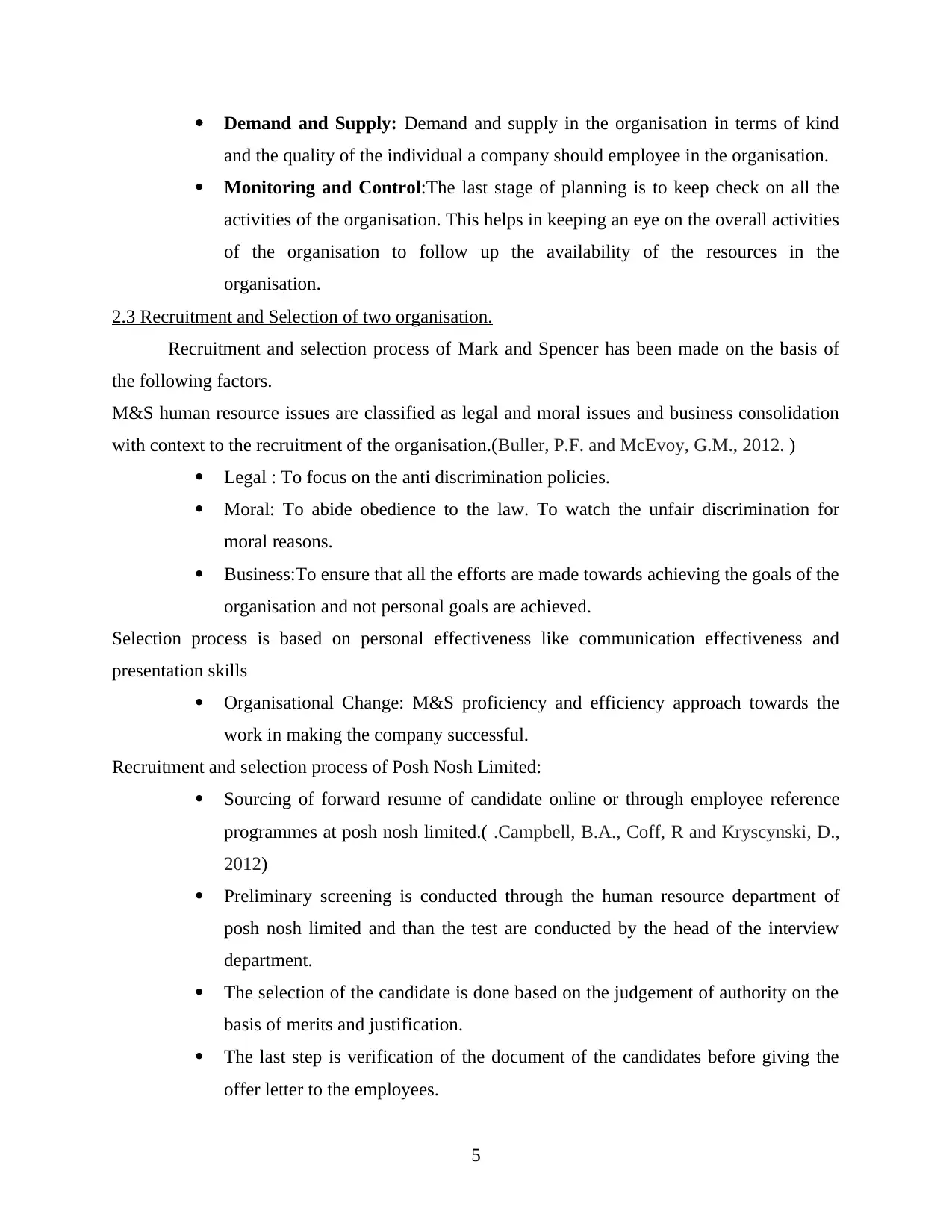
Demand and Supply: Demand and supply in the organisation in terms of kind
and the quality of the individual a company should employee in the organisation.
Monitoring and Control:The last stage of planning is to keep check on all the
activities of the organisation. This helps in keeping an eye on the overall activities
of the organisation to follow up the availability of the resources in the
organisation.
2.3 Recruitment and Selection of two organisation.
Recruitment and selection process of Mark and Spencer has been made on the basis of
the following factors.
M&S human resource issues are classified as legal and moral issues and business consolidation
with context to the recruitment of the organisation.(Buller, P.F. and McEvoy, G.M., 2012. )
Legal : To focus on the anti discrimination policies.
Moral: To abide obedience to the law. To watch the unfair discrimination for
moral reasons.
Business:To ensure that all the efforts are made towards achieving the goals of the
organisation and not personal goals are achieved.
Selection process is based on personal effectiveness like communication effectiveness and
presentation skills
Organisational Change: M&S proficiency and efficiency approach towards the
work in making the company successful.
Recruitment and selection process of Posh Nosh Limited:
Sourcing of forward resume of candidate online or through employee reference
programmes at posh nosh limited.( .Campbell, B.A., Coff, R and Kryscynski, D.,
2012)
Preliminary screening is conducted through the human resource department of
posh nosh limited and than the test are conducted by the head of the interview
department.
The selection of the candidate is done based on the judgement of authority on the
basis of merits and justification.
The last step is verification of the document of the candidates before giving the
offer letter to the employees.
5
and the quality of the individual a company should employee in the organisation.
Monitoring and Control:The last stage of planning is to keep check on all the
activities of the organisation. This helps in keeping an eye on the overall activities
of the organisation to follow up the availability of the resources in the
organisation.
2.3 Recruitment and Selection of two organisation.
Recruitment and selection process of Mark and Spencer has been made on the basis of
the following factors.
M&S human resource issues are classified as legal and moral issues and business consolidation
with context to the recruitment of the organisation.(Buller, P.F. and McEvoy, G.M., 2012. )
Legal : To focus on the anti discrimination policies.
Moral: To abide obedience to the law. To watch the unfair discrimination for
moral reasons.
Business:To ensure that all the efforts are made towards achieving the goals of the
organisation and not personal goals are achieved.
Selection process is based on personal effectiveness like communication effectiveness and
presentation skills
Organisational Change: M&S proficiency and efficiency approach towards the
work in making the company successful.
Recruitment and selection process of Posh Nosh Limited:
Sourcing of forward resume of candidate online or through employee reference
programmes at posh nosh limited.( .Campbell, B.A., Coff, R and Kryscynski, D.,
2012)
Preliminary screening is conducted through the human resource department of
posh nosh limited and than the test are conducted by the head of the interview
department.
The selection of the candidate is done based on the judgement of authority on the
basis of merits and justification.
The last step is verification of the document of the candidates before giving the
offer letter to the employees.
5
Paraphrase This Document
Need a fresh take? Get an instant paraphrase of this document with our AI Paraphraser
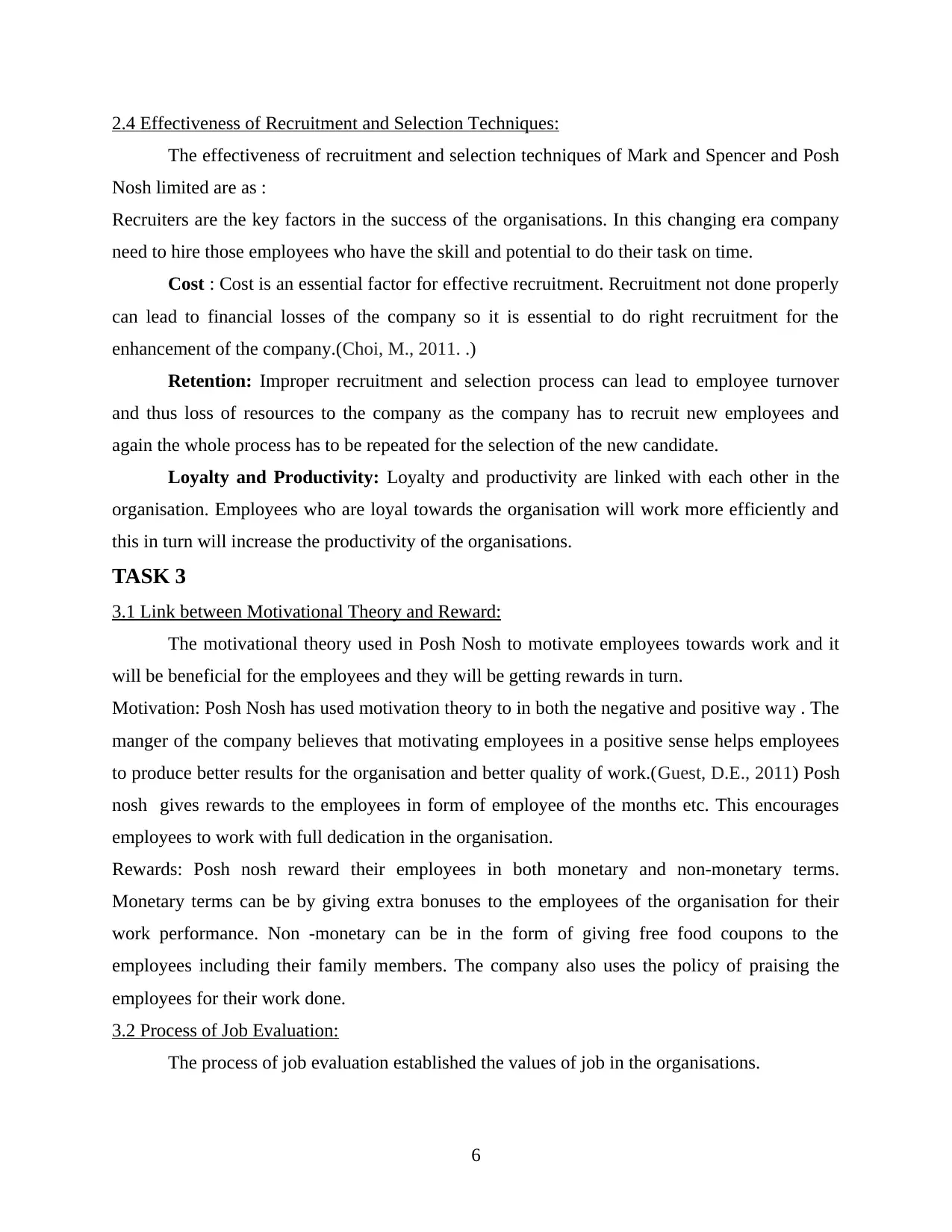
2.4 Effectiveness of Recruitment and Selection Techniques:
The effectiveness of recruitment and selection techniques of Mark and Spencer and Posh
Nosh limited are as :
Recruiters are the key factors in the success of the organisations. In this changing era company
need to hire those employees who have the skill and potential to do their task on time.
Cost : Cost is an essential factor for effective recruitment. Recruitment not done properly
can lead to financial losses of the company so it is essential to do right recruitment for the
enhancement of the company.(Choi, M., 2011. .)
Retention: Improper recruitment and selection process can lead to employee turnover
and thus loss of resources to the company as the company has to recruit new employees and
again the whole process has to be repeated for the selection of the new candidate.
Loyalty and Productivity: Loyalty and productivity are linked with each other in the
organisation. Employees who are loyal towards the organisation will work more efficiently and
this in turn will increase the productivity of the organisations.
TASK 3
3.1 Link between Motivational Theory and Reward:
The motivational theory used in Posh Nosh to motivate employees towards work and it
will be beneficial for the employees and they will be getting rewards in turn.
Motivation: Posh Nosh has used motivation theory to in both the negative and positive way . The
manger of the company believes that motivating employees in a positive sense helps employees
to produce better results for the organisation and better quality of work.(Guest, D.E., 2011) Posh
nosh gives rewards to the employees in form of employee of the months etc. This encourages
employees to work with full dedication in the organisation.
Rewards: Posh nosh reward their employees in both monetary and non-monetary terms.
Monetary terms can be by giving extra bonuses to the employees of the organisation for their
work performance. Non -monetary can be in the form of giving free food coupons to the
employees including their family members. The company also uses the policy of praising the
employees for their work done.
3.2 Process of Job Evaluation:
The process of job evaluation established the values of job in the organisations.
6
The effectiveness of recruitment and selection techniques of Mark and Spencer and Posh
Nosh limited are as :
Recruiters are the key factors in the success of the organisations. In this changing era company
need to hire those employees who have the skill and potential to do their task on time.
Cost : Cost is an essential factor for effective recruitment. Recruitment not done properly
can lead to financial losses of the company so it is essential to do right recruitment for the
enhancement of the company.(Choi, M., 2011. .)
Retention: Improper recruitment and selection process can lead to employee turnover
and thus loss of resources to the company as the company has to recruit new employees and
again the whole process has to be repeated for the selection of the new candidate.
Loyalty and Productivity: Loyalty and productivity are linked with each other in the
organisation. Employees who are loyal towards the organisation will work more efficiently and
this in turn will increase the productivity of the organisations.
TASK 3
3.1 Link between Motivational Theory and Reward:
The motivational theory used in Posh Nosh to motivate employees towards work and it
will be beneficial for the employees and they will be getting rewards in turn.
Motivation: Posh Nosh has used motivation theory to in both the negative and positive way . The
manger of the company believes that motivating employees in a positive sense helps employees
to produce better results for the organisation and better quality of work.(Guest, D.E., 2011) Posh
nosh gives rewards to the employees in form of employee of the months etc. This encourages
employees to work with full dedication in the organisation.
Rewards: Posh nosh reward their employees in both monetary and non-monetary terms.
Monetary terms can be by giving extra bonuses to the employees of the organisation for their
work performance. Non -monetary can be in the form of giving free food coupons to the
employees including their family members. The company also uses the policy of praising the
employees for their work done.
3.2 Process of Job Evaluation:
The process of job evaluation established the values of job in the organisations.
6
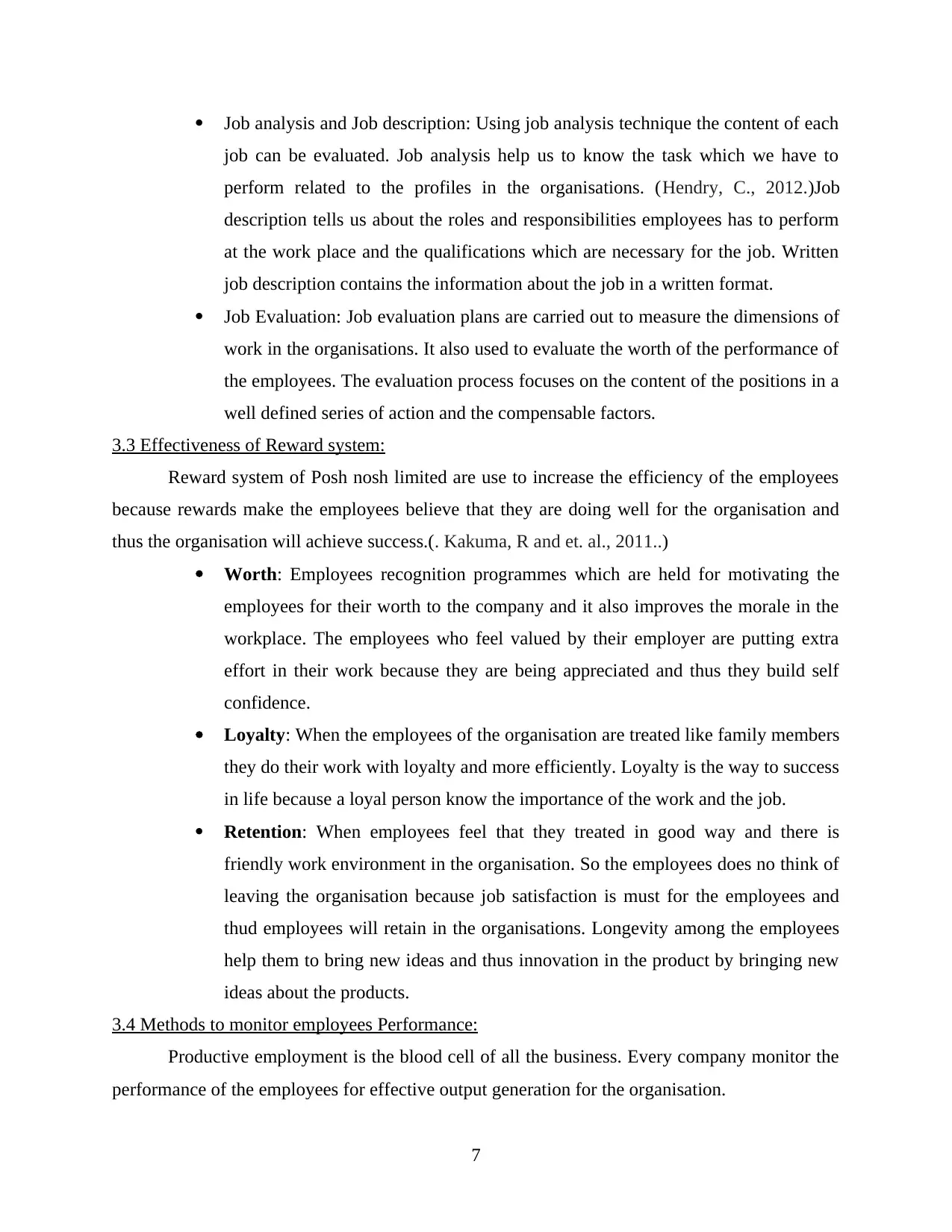
Job analysis and Job description: Using job analysis technique the content of each
job can be evaluated. Job analysis help us to know the task which we have to
perform related to the profiles in the organisations. (Hendry, C., 2012.)Job
description tells us about the roles and responsibilities employees has to perform
at the work place and the qualifications which are necessary for the job. Written
job description contains the information about the job in a written format.
Job Evaluation: Job evaluation plans are carried out to measure the dimensions of
work in the organisations. It also used to evaluate the worth of the performance of
the employees. The evaluation process focuses on the content of the positions in a
well defined series of action and the compensable factors.
3.3 Effectiveness of Reward system:
Reward system of Posh nosh limited are use to increase the efficiency of the employees
because rewards make the employees believe that they are doing well for the organisation and
thus the organisation will achieve success.(. Kakuma, R and et. al., 2011..)
Worth: Employees recognition programmes which are held for motivating the
employees for their worth to the company and it also improves the morale in the
workplace. The employees who feel valued by their employer are putting extra
effort in their work because they are being appreciated and thus they build self
confidence.
Loyalty: When the employees of the organisation are treated like family members
they do their work with loyalty and more efficiently. Loyalty is the way to success
in life because a loyal person know the importance of the work and the job.
Retention: When employees feel that they treated in good way and there is
friendly work environment in the organisation. So the employees does no think of
leaving the organisation because job satisfaction is must for the employees and
thud employees will retain in the organisations. Longevity among the employees
help them to bring new ideas and thus innovation in the product by bringing new
ideas about the products.
3.4 Methods to monitor employees Performance:
Productive employment is the blood cell of all the business. Every company monitor the
performance of the employees for effective output generation for the organisation.
7
job can be evaluated. Job analysis help us to know the task which we have to
perform related to the profiles in the organisations. (Hendry, C., 2012.)Job
description tells us about the roles and responsibilities employees has to perform
at the work place and the qualifications which are necessary for the job. Written
job description contains the information about the job in a written format.
Job Evaluation: Job evaluation plans are carried out to measure the dimensions of
work in the organisations. It also used to evaluate the worth of the performance of
the employees. The evaluation process focuses on the content of the positions in a
well defined series of action and the compensable factors.
3.3 Effectiveness of Reward system:
Reward system of Posh nosh limited are use to increase the efficiency of the employees
because rewards make the employees believe that they are doing well for the organisation and
thus the organisation will achieve success.(. Kakuma, R and et. al., 2011..)
Worth: Employees recognition programmes which are held for motivating the
employees for their worth to the company and it also improves the morale in the
workplace. The employees who feel valued by their employer are putting extra
effort in their work because they are being appreciated and thus they build self
confidence.
Loyalty: When the employees of the organisation are treated like family members
they do their work with loyalty and more efficiently. Loyalty is the way to success
in life because a loyal person know the importance of the work and the job.
Retention: When employees feel that they treated in good way and there is
friendly work environment in the organisation. So the employees does no think of
leaving the organisation because job satisfaction is must for the employees and
thud employees will retain in the organisations. Longevity among the employees
help them to bring new ideas and thus innovation in the product by bringing new
ideas about the products.
3.4 Methods to monitor employees Performance:
Productive employment is the blood cell of all the business. Every company monitor the
performance of the employees for effective output generation for the organisation.
7
⊘ This is a preview!⊘
Do you want full access?
Subscribe today to unlock all pages.

Trusted by 1+ million students worldwide
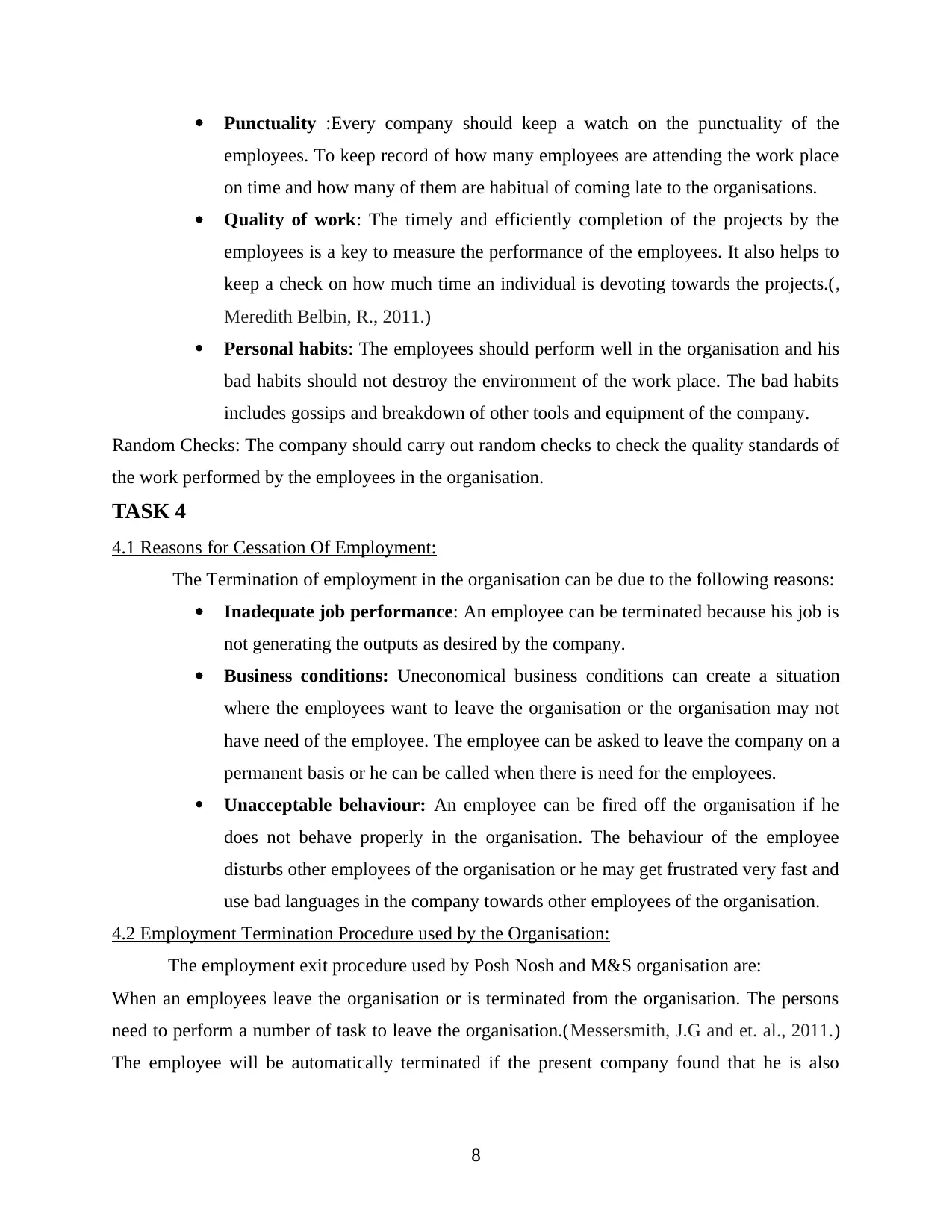
Punctuality :Every company should keep a watch on the punctuality of the
employees. To keep record of how many employees are attending the work place
on time and how many of them are habitual of coming late to the organisations.
Quality of work: The timely and efficiently completion of the projects by the
employees is a key to measure the performance of the employees. It also helps to
keep a check on how much time an individual is devoting towards the projects.(,
Meredith Belbin, R., 2011.)
Personal habits: The employees should perform well in the organisation and his
bad habits should not destroy the environment of the work place. The bad habits
includes gossips and breakdown of other tools and equipment of the company.
Random Checks: The company should carry out random checks to check the quality standards of
the work performed by the employees in the organisation.
TASK 4
4.1 Reasons for Cessation Of Employment:
The Termination of employment in the organisation can be due to the following reasons:
Inadequate job performance: An employee can be terminated because his job is
not generating the outputs as desired by the company.
Business conditions: Uneconomical business conditions can create a situation
where the employees want to leave the organisation or the organisation may not
have need of the employee. The employee can be asked to leave the company on a
permanent basis or he can be called when there is need for the employees.
Unacceptable behaviour: An employee can be fired off the organisation if he
does not behave properly in the organisation. The behaviour of the employee
disturbs other employees of the organisation or he may get frustrated very fast and
use bad languages in the company towards other employees of the organisation.
4.2 Employment Termination Procedure used by the Organisation:
The employment exit procedure used by Posh Nosh and M&S organisation are:
When an employees leave the organisation or is terminated from the organisation. The persons
need to perform a number of task to leave the organisation.(Messersmith, J.G and et. al., 2011.)
The employee will be automatically terminated if the present company found that he is also
8
employees. To keep record of how many employees are attending the work place
on time and how many of them are habitual of coming late to the organisations.
Quality of work: The timely and efficiently completion of the projects by the
employees is a key to measure the performance of the employees. It also helps to
keep a check on how much time an individual is devoting towards the projects.(,
Meredith Belbin, R., 2011.)
Personal habits: The employees should perform well in the organisation and his
bad habits should not destroy the environment of the work place. The bad habits
includes gossips and breakdown of other tools and equipment of the company.
Random Checks: The company should carry out random checks to check the quality standards of
the work performed by the employees in the organisation.
TASK 4
4.1 Reasons for Cessation Of Employment:
The Termination of employment in the organisation can be due to the following reasons:
Inadequate job performance: An employee can be terminated because his job is
not generating the outputs as desired by the company.
Business conditions: Uneconomical business conditions can create a situation
where the employees want to leave the organisation or the organisation may not
have need of the employee. The employee can be asked to leave the company on a
permanent basis or he can be called when there is need for the employees.
Unacceptable behaviour: An employee can be fired off the organisation if he
does not behave properly in the organisation. The behaviour of the employee
disturbs other employees of the organisation or he may get frustrated very fast and
use bad languages in the company towards other employees of the organisation.
4.2 Employment Termination Procedure used by the Organisation:
The employment exit procedure used by Posh Nosh and M&S organisation are:
When an employees leave the organisation or is terminated from the organisation. The persons
need to perform a number of task to leave the organisation.(Messersmith, J.G and et. al., 2011.)
The employee will be automatically terminated if the present company found that he is also
8
Paraphrase This Document
Need a fresh take? Get an instant paraphrase of this document with our AI Paraphraser
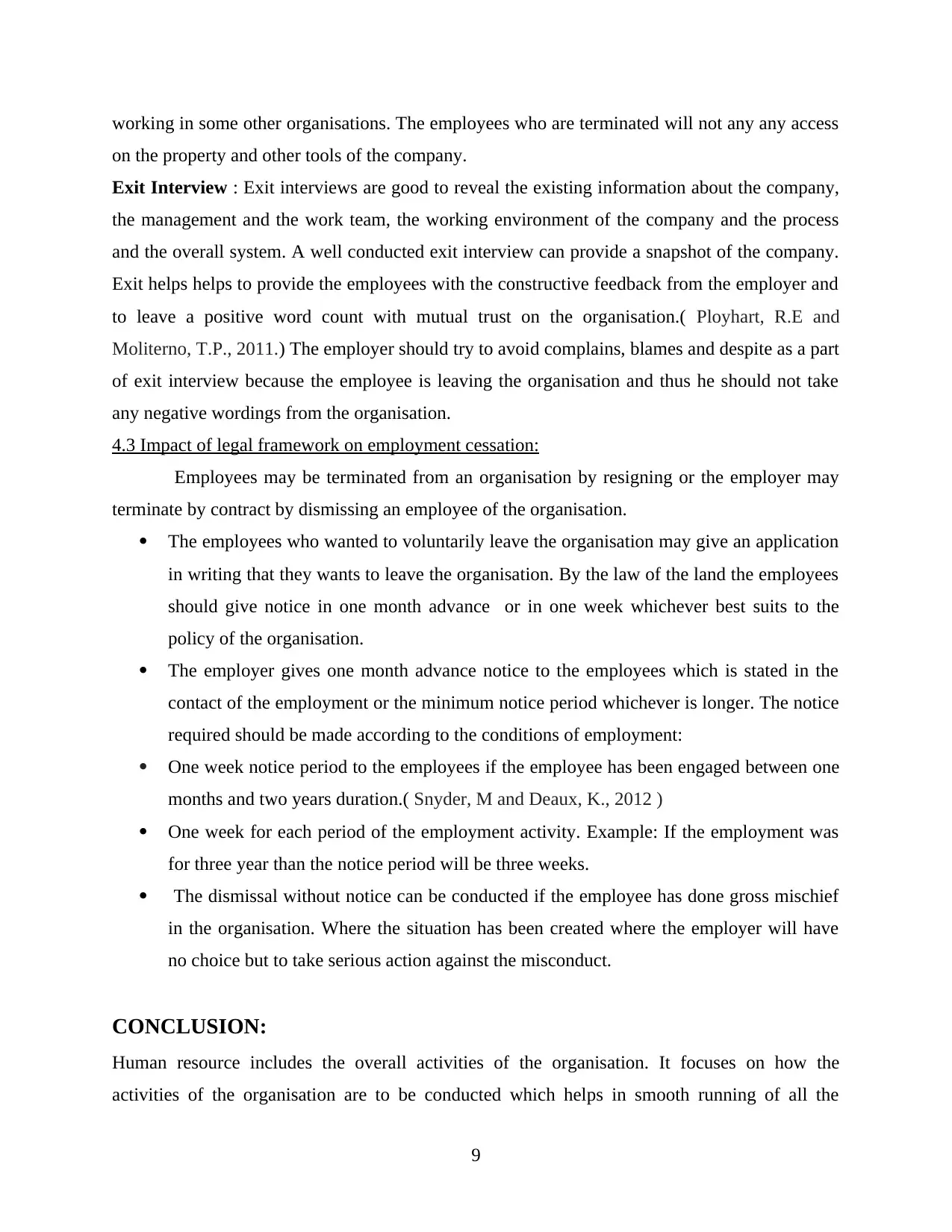
working in some other organisations. The employees who are terminated will not any any access
on the property and other tools of the company.
Exit Interview : Exit interviews are good to reveal the existing information about the company,
the management and the work team, the working environment of the company and the process
and the overall system. A well conducted exit interview can provide a snapshot of the company.
Exit helps helps to provide the employees with the constructive feedback from the employer and
to leave a positive word count with mutual trust on the organisation.( Ployhart, R.E and
Moliterno, T.P., 2011.) The employer should try to avoid complains, blames and despite as a part
of exit interview because the employee is leaving the organisation and thus he should not take
any negative wordings from the organisation.
4.3 Impact of legal framework on employment cessation:
Employees may be terminated from an organisation by resigning or the employer may
terminate by contract by dismissing an employee of the organisation.
The employees who wanted to voluntarily leave the organisation may give an application
in writing that they wants to leave the organisation. By the law of the land the employees
should give notice in one month advance or in one week whichever best suits to the
policy of the organisation.
The employer gives one month advance notice to the employees which is stated in the
contact of the employment or the minimum notice period whichever is longer. The notice
required should be made according to the conditions of employment:
One week notice period to the employees if the employee has been engaged between one
months and two years duration.( Snyder, M and Deaux, K., 2012 )
One week for each period of the employment activity. Example: If the employment was
for three year than the notice period will be three weeks.
The dismissal without notice can be conducted if the employee has done gross mischief
in the organisation. Where the situation has been created where the employer will have
no choice but to take serious action against the misconduct.
CONCLUSION:
Human resource includes the overall activities of the organisation. It focuses on how the
activities of the organisation are to be conducted which helps in smooth running of all the
9
on the property and other tools of the company.
Exit Interview : Exit interviews are good to reveal the existing information about the company,
the management and the work team, the working environment of the company and the process
and the overall system. A well conducted exit interview can provide a snapshot of the company.
Exit helps helps to provide the employees with the constructive feedback from the employer and
to leave a positive word count with mutual trust on the organisation.( Ployhart, R.E and
Moliterno, T.P., 2011.) The employer should try to avoid complains, blames and despite as a part
of exit interview because the employee is leaving the organisation and thus he should not take
any negative wordings from the organisation.
4.3 Impact of legal framework on employment cessation:
Employees may be terminated from an organisation by resigning or the employer may
terminate by contract by dismissing an employee of the organisation.
The employees who wanted to voluntarily leave the organisation may give an application
in writing that they wants to leave the organisation. By the law of the land the employees
should give notice in one month advance or in one week whichever best suits to the
policy of the organisation.
The employer gives one month advance notice to the employees which is stated in the
contact of the employment or the minimum notice period whichever is longer. The notice
required should be made according to the conditions of employment:
One week notice period to the employees if the employee has been engaged between one
months and two years duration.( Snyder, M and Deaux, K., 2012 )
One week for each period of the employment activity. Example: If the employment was
for three year than the notice period will be three weeks.
The dismissal without notice can be conducted if the employee has done gross mischief
in the organisation. Where the situation has been created where the employer will have
no choice but to take serious action against the misconduct.
CONCLUSION:
Human resource includes the overall activities of the organisation. It focuses on how the
activities of the organisation are to be conducted which helps in smooth running of all the
9

functions of the organisation and thus utilizing the resources of the organisations in an effective
and efficient way. Human resources function is to plan and coordinate activities of the different
department. The main function of HR is recruitment of the candidate which have the potential to
do the job in an effective manner and the person can generate output for the organisation.
Selection of the right candidate at the right place and at the right times which best suits with the
needs of the organisation.
10
and efficient way. Human resources function is to plan and coordinate activities of the different
department. The main function of HR is recruitment of the candidate which have the potential to
do the job in an effective manner and the person can generate output for the organisation.
Selection of the right candidate at the right place and at the right times which best suits with the
needs of the organisation.
10
⊘ This is a preview!⊘
Do you want full access?
Subscribe today to unlock all pages.

Trusted by 1+ million students worldwide
1 out of 14
Related Documents
Your All-in-One AI-Powered Toolkit for Academic Success.
+13062052269
info@desklib.com
Available 24*7 on WhatsApp / Email
![[object Object]](/_next/static/media/star-bottom.7253800d.svg)
Unlock your academic potential
Copyright © 2020–2025 A2Z Services. All Rights Reserved. Developed and managed by ZUCOL.





